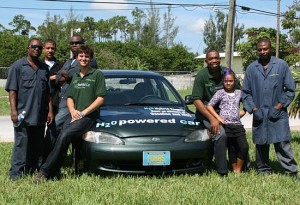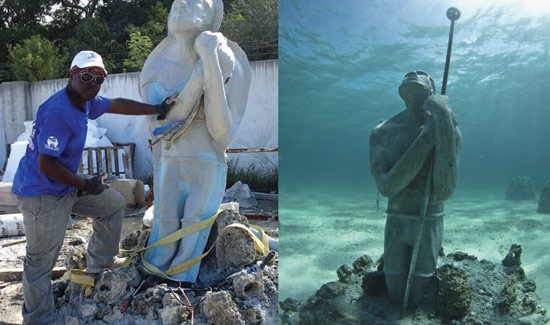
What is possibly Grand Bahama’s first water hybrid demonstration vehicle was displayed to members of the media this week by McGibbon’s Auto, the company which produced it.
The vehicle was built from a 1997 Hyundai Elantra with a 1.8 litre engine, in less than two months using local suppliers and materials.
The lead engineer-in-training on the project was 19-year-old James Tuchel, a mechanical engineering student at the University of Edinburgh in Scotland and former student of the Lucaya International School.
Tuchel was assisted with the project by Alexander Bethel, who recently graduated with a degree in automotive technology and McGibbon’s Auto technicians Moses Messam, Keith Johnson and Wilneve Rodney.
Tuchel was doing a two-month summer apprenticeship at McGibbon’s Auto under the tutelage of the owner, Avelaino McGibbon, who is a licensed Professional Automotive Mechanical Engineer.
McGibbon studied Auto-motive Engineering in Detroit and graduated from the General Motors Institute, which is now called Kettering University. He was privileged to engineer several automobiles for GM, Ford Chrysler other auto manufacturers, including amusement rides for Walt Disney and Universal studios. Among his accomplishments was the Super Sport Roadster truck for Chevrolet (2003 –2007).
A hybrid vehicle means that there is more than one source of energy for propelling the vehicle.
The water powered car produced at McGibbon’s demonstrates just one of several technology versions that constitutes a hybrid by taking its gasoline engine and altering it to use the elements in drinking water.
The hydrogen is taken from the water and combined with the gasoline. This dramatically improves fuel economy while significantly reducing exhaust emissions.
“The vehicle drives and feels the same as the original vehicle – possibly with slightly more pep,” McGibbon explains.
This technology uses the 12-volt electrical energy in the vehicle battery to separate the drinking water into Hydrogen and Oxygen- two useful elements that fuel the internal combustion engine. The elements boost the internal combustion process as it combines with gasoline entering the engine.
It is possible to run the vehicle purely on the elements within water, without any gasoline, however, McGibbon said that phase of the project will be left for future demonstration.
McGibbon explained that Tuchel was encouraged to select from a few future projects that McGibbon’s Auto plans to work on, and chose the water-powered car. The idea was to demonstrate that the components and services needed to build such a vehicle exist right within the local community.
McGibbon said to save time a few ingredients were purchased from abroad, however, given enough time, it is possible that local companies and suppliers may have been able to provide nearly all of the services in assisting the team to build this hybrid vehicle.
“I had no doubt that we could make this happen. It was just a matter of, ‘Could we do it in time, within a budget and considering all the materials involved?’ but it has all come together,” McGibbon said.
The project was successful, he continued, producing noteworthy results. Initial testing showed that there was a 30 percent increase in fuel economy, which represents a significant amount of savings at the pump. That figure was calculated using $4.21 as the price per gallon of fuel.
“The effective dollar amount that the person who went to the pump with this car would pay was approximately $2.84 per gallon,” he said.
There are some improvements to be made to the vehicle, he said, and the team expects to get up to 45 percent fuel efficiency in the near future.
The gasoline that is going into the engine to be used for propulsion is supplemented with HHO fuel which is coming from the vehicle’s on-board generation. We generate two parts hydrogen and one part oxygen, Tuchel explained.
“What that does is that it allows us higher fuel efficiency, by decreasing the use of gasoline, which is more expensive than the HHO being generated on-board,” he said.
According to McGibbon, under normal driving routines, the car uses approximately one litre of water, over a one month period; the equivalent being one gallon of water for four months of driving.
He said he sees the potential for the fuel-saving method to not just be demonstrated, but actually put into practice on the island.
“Our islands are uniquely positoned such that this type of technology would not have a problem with the water freezing as in other countries.”
Further demonstrations of the vehicle will be given in the future and members of the public are invited to ask questions about and examine the vehicle if they spot it around town.
Source: Freeport News



